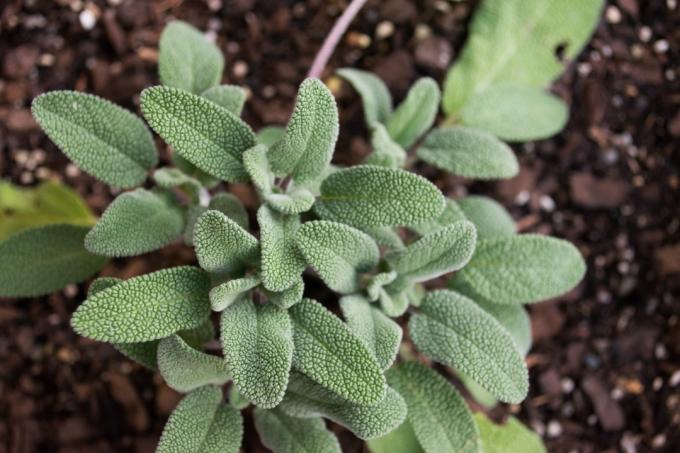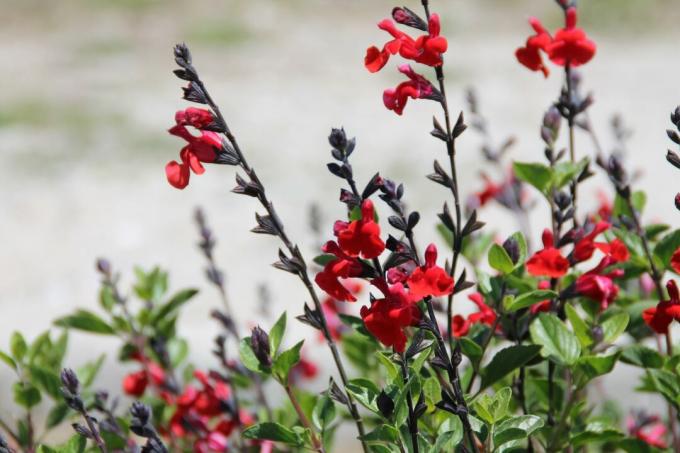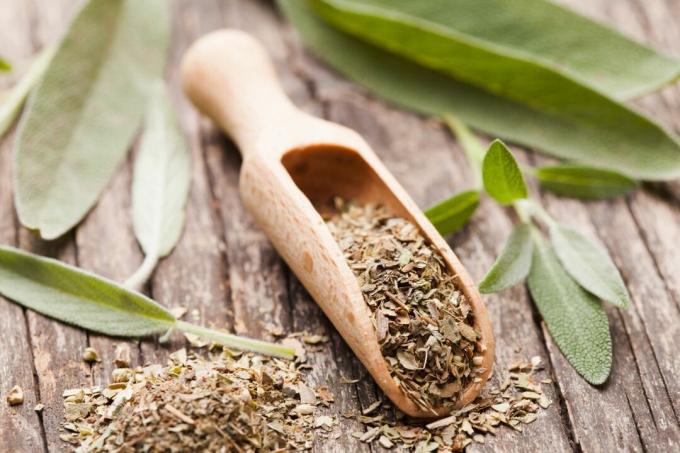You know sage from your own garden. Only a few know about its diversity of species and varieties: peach sage, honeydew melon sage and others.

The one belonging to the mint family sage (Salvia) is one of the most versatile herbs you can grow in your own garden. Scientifically referred to as Salvia, the name is derived from salvus (healthy) or salvare (to heal). Because the tasty herb has always been appreciated not only in the kitchen, but also in traditional medicine. A few more are still cultivated as ornamental plants, while the rest are mostly wild plants. Much of the commercially grown sage is used to make essential oils and fragrances.
contents
- Known sage species at a glance
- Varieties of Garden Sage
- Garden sage cultivation
- Harvest, store and preserve sage correctly
- ingredients and use
- diseases and pests
Known sage species at a glance
In addition to the well-known spice and garden sage (Salvia officinalis) there are countless other Salvia species. the
variety of sage includes about 800 to 900 different species. Some also have significance for humans and are used either for incense or as culinary herbs. The different types of sage differ not only in their use. The color spectrum of the flowers ranges from blue, which is classic for sage, to violet-purple, through orange and pink, to an intense scarlet red. Only a few selected species are presented below.- Cleveland Sage (Salvia clevelandii)
- Fruit sage (Salvia dorisiana)
- Garden sage (Salvia officialis)
- Honeydew melon sage (Salvia elegans)
- Indian smoked sage (Salvia apiana)
- clary sage (Salvia sclarea)
- Peruvian sage (Salvia discolor)
- Peach Sage (Salvia greggii)
- Black currant sage (Salvia microphylla)

There are also countless other types of sage. To name just a few more: fruit sage (Salvia dorisiana), shrub sage (Salvia heerii), Spanish sage (Salvia lavandulifolia) as well as the creeping sage (Salvia nevadensis). The Mexican Chia (Salvia hispanica) is grown to obtain the chia seeds that are currently in vogue. This species should not be confused with Spanish sage (Salvia lavandulifolia) to be confused.
Varieties of Garden Sage
Over the past centuries, the wild form of sage has been bred and selected. The main focus was on yield and aroma. The extractive sage variety, for example, is the record holder for the content of essential oils. Since the flowers tend to be a hindrance, especially for commercial herb cultivation, there is a flowerless sage variety called Non-Flower. In recent years, particularly multicolored varieties such as Creme de la Creme, Tricolor or Rotmühle have emerged. In the following we briefly present some well-established and good new breeds:
- Alba: White-flowering sage variety with quite compact growth; also suitable for keeping in buckets; intense, pleasant aroma; slightly bitter.
- mountain garden: Sage variety with large, broad leaves; therefore ideal for preparing saltimbocca or similar; very good aroma; quite compact growth.
- Crispa: Sage variety with a very special look: the leaves are quite wide, downy and clearly curled at the edges; very good aroma.
- extracta: breeding with a very high content of essential oils; particularly intense in taste and also suitable for smoking; Since you only need a few leaves for seasoning, one plant in the garden is usually sufficient.
- Nana Alba: Like Nana, only with white flowers; pleasant aroma; well suited to culture in pots.
- Nana: As the name suggests: very compact variety with small, narrow leaves; ideal for culture on the balcony.
- Nazareth: Very downy and silvery variety from Israel; Leaves are oblong, narrow; very good, intense aroma.
- non flower: Anyone who does not grow sage as an ornamental plant, but only to harvest the leaves, should fall back on this variety. This does not form flowers and can put all the energy into the formation of shoots and leaves. Flavorful and very good.
- rosea: Particularly beautiful variety with pink flowers; Quite small leaves for a cultivar, but with a sweetish aroma.
- Windeck: Similar large leaves and good aroma as Berggarten, but more vigorous; rather unsuitable for pot culture; but very good aroma and ideal leaf size for processing in the kitchen (saltimbocca, etc.).

Sage varieties with variegated leaves:
- Creme de la creme: Sage variety variegated to creamy white especially at the edges of the leaves; two-tone: creamy white - green.
- Aurea: Well-known type of sage, which is often also referred to as golden sage; golden-yellow to green-yellow variegated leaves; good taste.
- purpurascens: Leaves of the higher and younger shoots are violet in colour; later these become green-grey; beautiful appearance, good taste, but similar to the Tricolor variety only conditionally hardy.
- tricolor: Variety with a particularly beautiful leaf appearance: the leaves are white-green variegated, with the leaves in particular on the higher shoots turning purple to pink. Requires a very well-protected location in Germany, as it is less tolerant of frost than other varieties.
Garden sage cultivation
Although the sage found its way to us from the Mediterranean region, you can also find it in our preparations grow sage. The plant likes deep, slightly stony soil that is permeable to water. Similar to lavender, sage likes it chalky. Soils that are too acidic should be treated accordingly with garden lime. The location should be very sunny, hot and sheltered. If you want to do something good for the herb, put it on a stone wall or house wall. It heats up during the day and releases the heat again in the evening and at night.
Sage can be propagated from cuttings and seeds. Sow from late March to early April. Our Plantura Organic Herb & Seed Soil is ideal for this. The first flowering usually occurs after 2 years. Young plants should not be harvested too heavily, especially in the beginning, as they need the strength to grow. Even better results are achieved with cuttings. For this purpose, the younger, not yet lignified shoots in particular are separated from the mother plant and rooted under tense air (mini greenhouse, PET bottle, etc.).
Sage should be fertilized from time to time. However, you should not use fertilizer too often, as this can negatively affect both the taste and the winter hardiness. Older sage plants in particular tend to lignify from below. A topiary should therefore be carried out after flowering or in early spring. The plant is shortened by about 40-50 percent. Most sage varieties are hardy in Germany. In areas with a harsh climate or in exposed locations, you should protect the plant from the frosts with some brushwood or fleece. Some soil can also be piled up around the plant disc. This also protects the root system. If you want to grow multicolored sage varieties such as Tricolor or Purpurascens, you should pay particular attention to appropriate winter protection. Both varieties are considered winter hardy down to around -12 °C. This means that the two varieties can only be grown in climatically favorable wine-growing regions. However, sage can also be grown in a larger terracotta pot on the patio. You simply put it in the gazebo or an unheated garage over the winter.

Harvest, store and preserve sage correctly
Sage leaves can be harvested from late spring to autumn. If you pinch off the young shoots, this promotes the branching of the plant. In the long run you get ready and bushy plants. The young sage leaves go well with all kinds of dishes, which will be discussed in more detail in the following section. The leaves have the best flavor before flowering. But even during and after flowering, the aroma is more than sufficient for processing. The sage flowers are edible. They can be used to decorate dishes beautifully.

to store sage is a bit easier than with thin-leaved herbs like basil or coriander. Sage can be stored in the refrigerator for up to two weeks. To do this, it is best to leave the leaves on the stalk and wrap the bunch of herbs in a slightly damp kitchen towel. You can often buy dried sage in grocery stores. Although the dried leaves still taste good, most of the flavors are lost. Even if many gardeners don't have it on their radar, sage is great for freezing. We particularly recommend this if you want to add the herb to a butter sauce.
ingredients and use
The medicinal herb connoisseur knows that the "officinalis" in the Latin name of sage indicates its use in medicine. The many essential oils in particular are used in folk medicine to treat cramps, inflammation and sweating. The substances thujone and cineol in particular are of significant importance here. If you brew sage into a tea, it tastes bitter, but it is precisely these bitter substances that are important for its anti-inflammatory effect. In addition, it contains basic herb many minerals such as iron and magnesium.
However, as with all foods, one must exercise caution and limit intake to a normal dose. Because thujone and camphor are poisonous in high doses. Sage should also be avoided during pregnancy.

As a culinary herb, sage is particularly popular with meat and fish. It goes particularly well with veal, lamb, poultry or rabbit. Sage is also used in pot roasts. Although you can no longer perceive the taste in detail after the long cooking process, sage rounds off the overall impression of the gravy well. The sage also rounds off the taste well with oily fish such as sea bream, eel or moray eel. It is best to place one or two leaves in the abdomen during cooking. However, sage does not only go well with pure meat dishes, but together with butter or olive oil, for example, gives gnocchi its unmistakable taste. The herb also goes extremely well with pasta with mushrooms.
Important: Sage dissolves the aromas best in fat. The leaves are heated in olive oil or butter. However, this process should be carried out as slowly and gently as possible. Temperatures that are too high destroy many of the valuable ingredients and aromas. The fat should always remain below its smoke point when heated!
In addition to being used as a tea or herb, particularly hearty sage varieties such as Nazareth or extracts can be used for smoking. If you have enough space in the garden, you can also plant Indian smoked sage (Salvia apiana).
tip: In addition to sage, a few others are also suitable herbs for grilling. We have compiled the best of them in an overview.
diseases and pests
Sage has the biggest problems with the culture conditions. Waterlogging and severe frosts are poorly tolerated. Diseases and pests rarely occur in your own garden. Partly he can powdery mildew appear. Occasionally also occur spider mites on. However, both adversities can be overcome without much use of chemicals.
Are you also an avid sage fan? Please share your experiences with us. We are happy!



